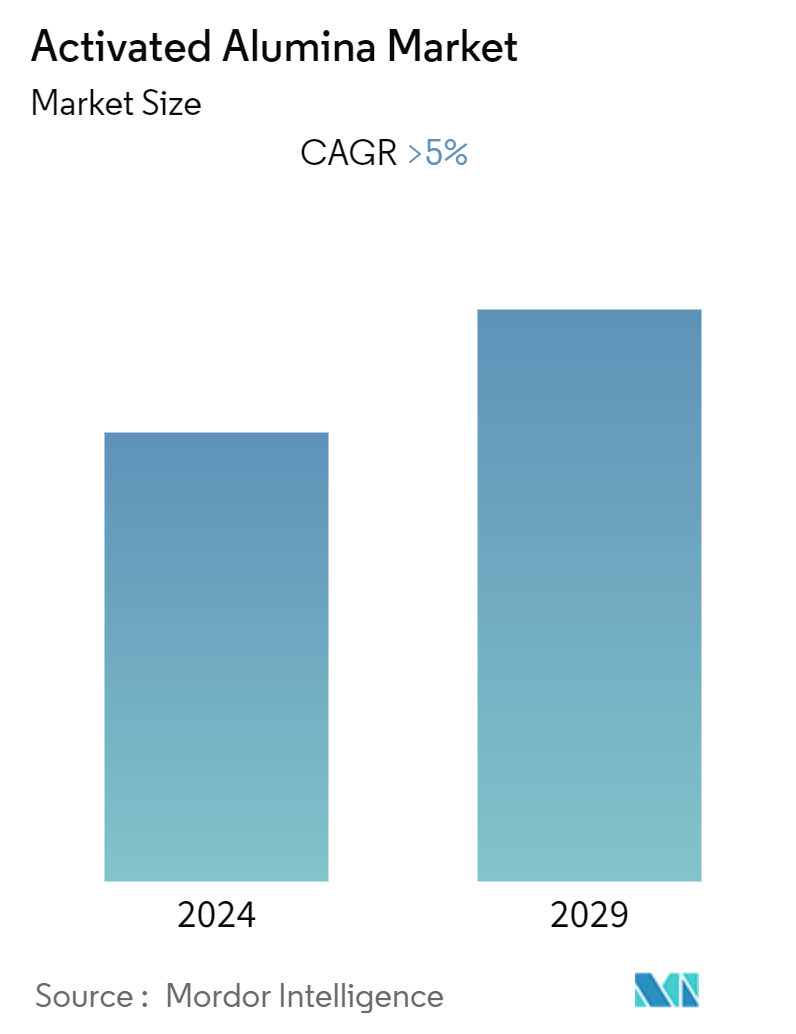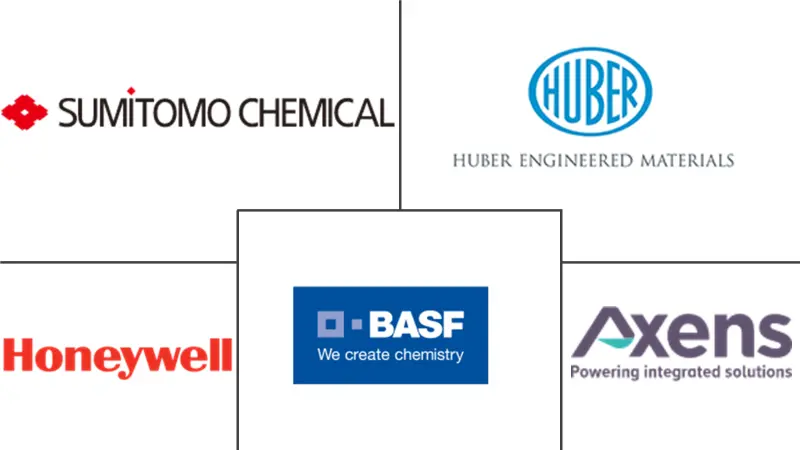Market Size of Activated Alumina Industry

| Study Period | 2019 - 2029 |
| Base Year For Estimation | 2023 |
| CAGR (2024 - 2029) | 5.00 % |
| Fastest Growing Market | Asia-Pacific |
| Largest Market | Asia-Pacific |
| Market Concentration | High |
Major Players
*Disclaimer: Major Players sorted in no particular order |
Activated Alumina Market Analysis
The Activated Alumina Market is expected to register a CAGR of greater than 5% during the forecast period.
Activated alumina, a highly porous form of aluminum oxide, is widely used across various industries due to its excellent adsorption properties. The market for activated alumina is influenced by several factors, which range from environmental concerns to its increasing utility in niche sectors like pharmaceuticals and water treatment. The market's structure is dynamic, with several competing forces shaping its evolution, from the availability of substitutes to the strategic moves by key players in the industry.
Growth Drivers:
- Environmental Concerns: In recent years, the increasing concerns related to water pollution by fluorine have significantly impacted the activated alumina market. The material's ability to adsorb contaminants like fluoride from water sources has led to its growing adoption in water treatment applications. As governments and environmental agencies enforce stricter regulations on water quality, the demand for activated alumina in water treatment is likely to remain strong. This is particularly evident in regions where fluorine contamination in water supplies is a critical issue, such as in parts of Asia-Pacific and Africa.
- Pharmaceutical Applications: The gaining significance of activated alumina in the pharmaceutical industry has also contributed to its growing demand. In this industry, activated alumina is utilized as a desiccant to maintain the integrity of pharmaceutical products by controlling moisture levels during storage and transportation. This characteristic is crucial for preserving the efficacy and shelf life of sensitive drugs, especially in regions with high humidity levels.
Market Challenges and Opportunities:
Competition from Substitutes
- However, the market is not without challenges. The presence of substitutes poses a notable restraint, as alternative materials like silica gel and molecular sieves can be used for similar applications. These alternatives are often preferred due to their cost-effectiveness and specific performance advantages in certain scenarios, such as higher adsorption capacity or more favorable regeneration characteristics. This competition from substitutes compels manufacturers to focus on improving the performance and cost-efficiency of activated alumina to maintain their market position.
Adoption Driven by Environmental Concerns
- Water Treatment Industry: Activated alumina is increasingly essential in addressing water pollution, particularly in the adsorption of fluorine from water supplies. The material's unique adsorption properties make it an effective solution for mitigating the harmful effects of fluorine, which can have severe health impacts when present in drinking water. The heightened focus on environmental sustainability and stricter regulations concerning water quality have led to a rise in activated alumina's demand, particularly in the water treatment industry. This trend is especially prominent in developing regions where water pollution is a significant concern.
- Governmental Support: Governments and environmental agencies are increasingly promoting the use of activated alumina in water treatment processes, further driving its adoption. This support is crucial in regions where natural water sources are heavily contaminated, necessitating efficient and cost-effective treatment solutions.
Rising Importance in Pharmaceuticals
- Desiccant Applications: The pharmaceutical industry has recognized the importance of activated alumina as a desiccant, which is vital for maintaining the stability and shelf life of various pharmaceutical products. Activated alumina's ability to control moisture levels is critical in ensuring the safety and efficacy of these products, particularly in tropical and subtropical regions with high humidity.
- Increasing Reliance: With the increasing complexity of pharmaceutical formulations and the growing demand for moisture-sensitive drugs, the reliance on activated alumina is expected to grow. This trend is particularly relevant as the global pharmaceutical industry expands, with emerging markets playing a key role in this growth. The material's versatility and effectiveness in various pharmaceutical applications, such as in packaging and storage, make it a valuable asset in the industry. As pharmaceutical companies continue to innovate and develop new products, the demand for reliable desiccants like activated alumina is likely to increase.
Activated Alumina Industry Segmentation
Activated alumina is a highly porous aluminum hydroxide with a large surface area. It is used in a wide range of applications, such as catalysts, bioceramics, fluoride adsorbents, and others. It can absorb toxic materials from wastewater and aquifers. Application, end-user industry, and geography are the market segments for activated alumina. By application, the market is segmented into catalyst, desiccant, adsorbent, and other applications. By end-user industry, the market is segmented into oil and gas, water treatment, chemicals, healthcare, and other end-user industries. The report also covers the market size and forecasts in 15 countries across major regions. For each segment, market sizing and forecasts have been done on the basis of revenue (USD million).
| Application | |
| Adsorbent | |
| Desiccant | |
| Catalyst | |
| Other Applications |
| End-user Industry | |
| Oil and Gas | |
| Water Treatment | |
| Chemical | |
| Healthcare | |
| Other End-user Industries |
| Geography | |||||||
| |||||||
| |||||||
| |||||||
| |||||||
|
Activated Alumina Market Size Summary
The activated alumina market is poised for steady growth, driven by increasing concerns over water pollution and its rising significance in the pharmaceutical industry. Despite challenges from substitutes like activated carbon and zeolites, the market is expected to benefit from new applications in textiles and cosmetics. The Asia-Pacific region, particularly China, India, and Japan, is anticipated to be the largest and fastest-growing market due to its substantial consumption. The oil and gas industry also plays a crucial role in driving demand, as activated alumina is essential for removing water from natural gas streams, supporting the sector's expansion. The establishment of new refinery projects and the growing need for energy security in countries like China and India further bolster market prospects.
The demand for activated alumina is expected to rise significantly, supported by increasing freshwater supply needs and rising expenditure on water treatment infrastructure. Government initiatives, such as India's Jal Jeevan Mission, aim to enhance water management and attract private investment in wastewater treatment, contributing to market growth. The burgeoning oil and gas industry in the region, along with Japan's status as a major energy consumer, adds to the market's expansion. The market is consolidated, with key players like BASF SE, Huber Engineered Materials, and Honeywell International Inc. actively participating. Recent investments, such as Evonik's expansion in Japan and Axens' acquisition in Canada, highlight ongoing efforts to tap into new markets and applications, ensuring robust growth during the forecast period.
Activated Alumina Market Size - Table of Contents
-
1. MARKET DYNAMICS
-
1.1 Drivers
-
1.1.1 Increasing Concerns Related to Water Pollution by Fluorine
-
1.1.2 Gaining Significance in Pharmaceutical Industry
-
-
1.2 Restraints
-
1.2.1 Presence of Substitutes
-
1.2.2 Other Restraints
-
-
1.3 Industry Value Chain Analysis
-
1.4 Porter's Five Forces Analysis
-
1.4.1 Bargaining Power of Suppliers
-
1.4.2 Bargaining Power of Buyers
-
1.4.3 Threat of New Entrants
-
1.4.4 Threat of Substitute Products and Services
-
1.4.5 Degree of Competition
-
-
-
2. MARKET SEGMENTATION (Market Size in Value)
-
2.1 Application
-
2.1.1 Adsorbent
-
2.1.2 Desiccant
-
2.1.3 Catalyst
-
2.1.4 Other Applications
-
-
2.2 End-user Industry
-
2.2.1 Oil and Gas
-
2.2.2 Water Treatment
-
2.2.3 Chemical
-
2.2.4 Healthcare
-
2.2.5 Other End-user Industries
-
-
2.3 Geography
-
2.3.1 Asia-Pacific
-
2.3.1.1 China
-
2.3.1.2 India
-
2.3.1.3 Japan
-
2.3.1.4 South Korea
-
2.3.1.5 Rest of Asia-Pacific
-
-
2.3.2 North America
-
2.3.2.1 United States
-
2.3.2.2 Canada
-
2.3.2.3 Mexico
-
-
2.3.3 Europe
-
2.3.3.1 Germany
-
2.3.3.2 United Kingdom
-
2.3.3.3 France
-
2.3.3.4 Italy
-
2.3.3.5 Rest of Europe
-
-
2.3.4 South America
-
2.3.4.1 Brazil
-
2.3.4.2 Argentina
-
2.3.4.3 Rest of South America
-
-
2.3.5 Middle-East and Africa
-
2.3.5.1 Saudi Arabia
-
2.3.5.2 South Africa
-
2.3.5.3 Rest of Middle-East and Africa
-
-
-
Activated Alumina Market Size FAQs
What is the current Activated Alumina Market size?
The Activated Alumina Market is projected to register a CAGR of greater than 5% during the forecast period (2024-2029)
Who are the key players in Activated Alumina Market?
BASF SE, Axens, Sumitomo Chemical Co., Ltd., Honeywell International Inc. and Huber Engineered Materials are the major companies operating in the Activated Alumina Market.

